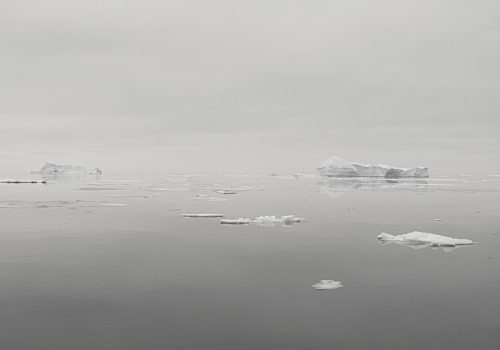There is always a moment in the life of an artist, of a researcher or of everyone, where questions about the state of the world come together with questions about one’s personal destiny; or to put it more modestly, of its particular trajectory. There is always a moment and there is often a place. This point of convergence easily takes on a little extreme … great departure or return to the origins, ultimate experience or abyssal withdrawal, mountainous peaks or seabed. Brilliance or discrete determined seclusion. Key or transitional moments , that do not necessarily emphasize big clamor; On the contrary, they can appear almost imperceptible, drift or melt without making any noise.
The poles, these days, seem to be popular; why, or how. No one now knows, however, that he will no longer be the first and will not be the last. But lands end fascinate and the need to try is tenacious. It is by the extremities that we burn, live and perish; it is on the edge of the world, all apparently deserted, or at least sparsely populated, that anxiety about the future of our common existence takes shape. There is more than snobbery or exoticism: the desperate search for an asylum, perhaps; a way to push back or question our limits; the intimate experience of passing, of discovery; the meeting of the I and the we, in the middle of nothing and nobody. No need to go bare-handed or take heroic risks, looking and thinking may be enough for this confrontation … this vertigo, perhaps, once taken the measure, alas probably definitive, of the incapacity of man on earth to ensure his own permanence, even to maintain any form of life, preserved from nuisance. The whiteness of the poles, their fascinating mystery – now somewhat dulled, rare are the mysteries that our consumer and communication societies have not managed to blunt – remain, for the body and the mind, a radical shock; and also, for the eye, a powerful magnet.
Joël Van Audenhaege is not a homebody; it is not for all that a fighter. he is someone whom his experience as a publisher has often confronted with the images of others, without, however, renouncing, from time to time, to pick up his own apparatus or his own obsessions. He is a lover of the sea and the horizon, a passenger of the world who needs to grasp its beauty and to keep its traces – analog or digital, in color, in black and white or instant photographs . But no matter where we go and whatever the means used the disturbing silence becomes deafening, just interrupted here and there by the thundering debility of some world leader. We, humanity, now know that we are sadly soluble; and since Edward Burtynsky has been sufficiently known – or more naively since Arthus-Bertrand – the thin wall which separates the documentation from this finitude, from its contemplation; and beauty, dread.
“Under the apparent indolence mineral conceals the history of humanity,” wrote the hedonistic philosopher Michel Onfray, who left a few years ago to confront the North Pole and take, at age 80, his father who dreamed ( Aesthetics of the North Pole, Grasset, 2002). “In the Far North, space absorbs time and materializes it into sublime expanses. Vastitude transfigures the human being into a fragment, a small piece set in a limited time, but evolving into eternity from a perspective as far as the eye can see. Between day and night, between the cold and the immensity, between the stone and the now invisible animal, one can also read the story of an acculturation – even of a genocide -, of an abandonment, of an extinction. Renaissance or death sentence? Beyond the ethnological, philosophical, spiritual and poetic dimensions, Onfray was able to designate above all this mythical place, which has become almost trivial, as a possible refuge for the reconciliation of ethical and aesthetic issues.
It is, in his way, all his relation to the world that the photographer Joël Van Audenhaege gives us, while questioning ours. Somewhere between these desperate struggles that are said to be the most beautiful – and dirty purity, which send shivers down your spine.
Emmanuel d’Autreppe
The Darkest Night
Even the darkest night will end and the sun will rise. Victor Hugo
Photographs: Joël Van Audenhaege
Text: Emmanuel d’Autreppe
96 pages – 27 x 23 cm
300 copies – text in French and English
84 four-color and black / white photographs
ISBN 978-2-930115-64-1
PAON Diffusion
















